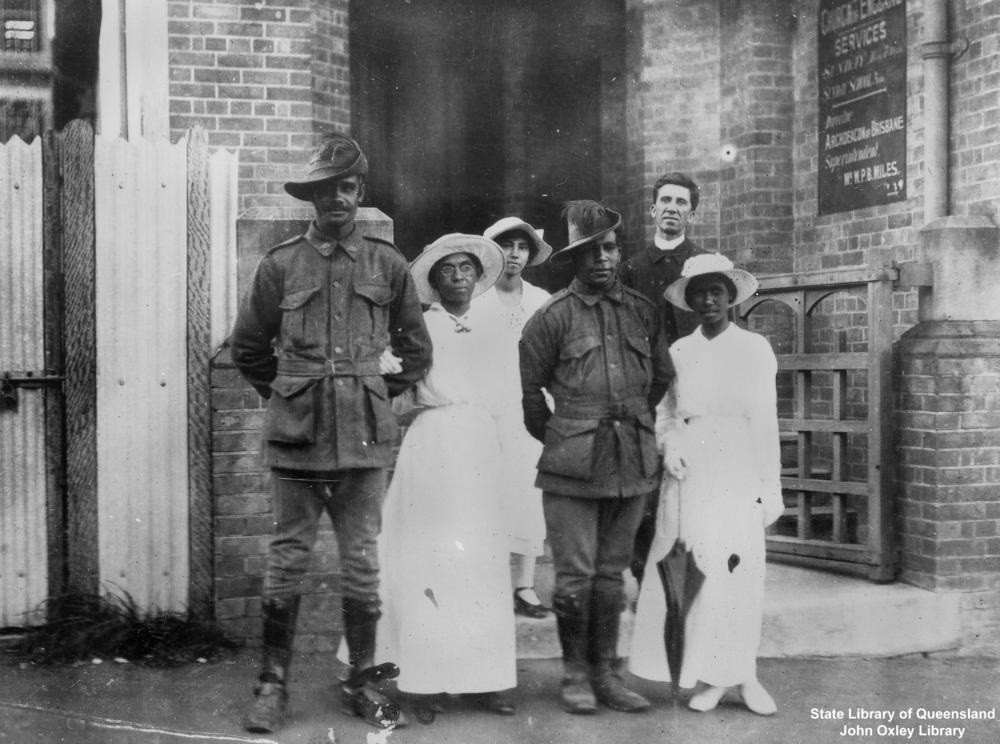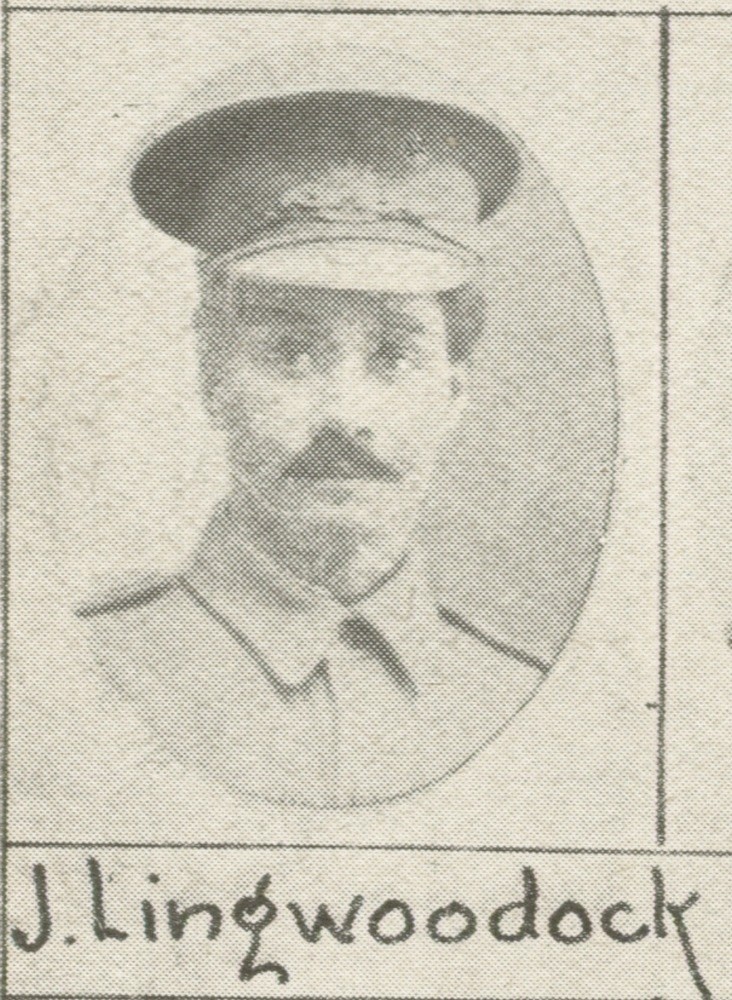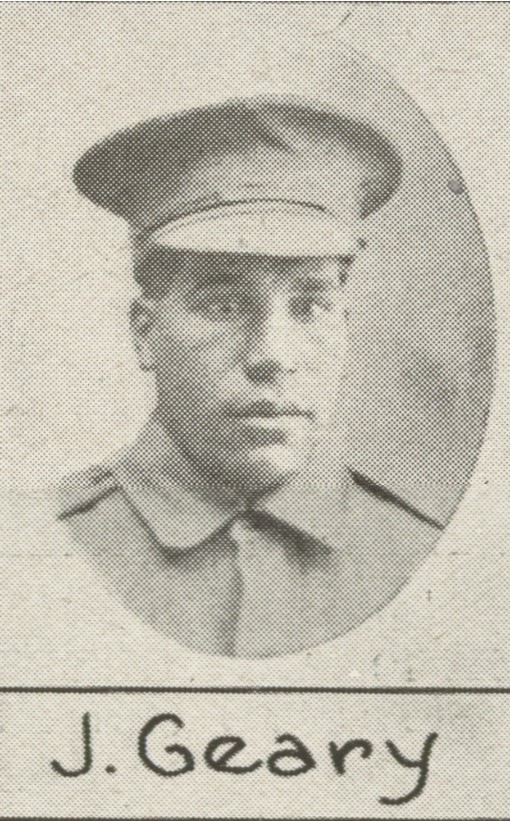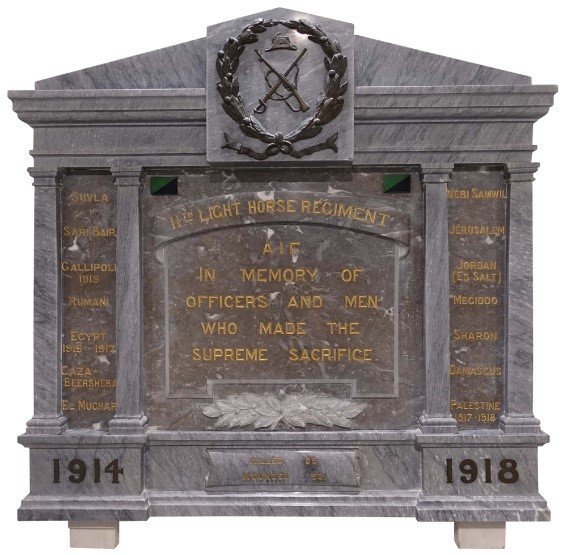James Lingwoodock and John Geary: Remembrance Day 2021
By Alice Rawkins, Visitor Services Assistant, Anzac Square Memorial Galleries | 2 November 2021
During World War One over 1,300 Aboriginal and Torres Strait Islanders served in the Australian Imperial Force (AIF). James Lingwoodock and John Geary, pictured below, were two of more than 20 Aboriginal men comprising part of the 20th Reinforcements for the 11th Light Horse Regiment, later known as the 'Queensland Black Watch'. They married their sweethearts in a joint service at St Luke’s Church of England in Charlotte Street, Brisbane, on 13 December 1917, before their departure to Egypt aboard the HMAT ‘Ulysses’ on 19 December 1917.

Servicemen’s wedding at St Lukes Church, Charlotte Street, Brisbane, 13 December 1917. John Oxley Library, State Library of Queensland. Negative number: 60511.
James Lingwoodock

J. Lingwoodock, one of the soldiers photographed in The Queenslander Pictorial, supplement to The Queenslander, 1917. John Oxley Library, State Library of Queensland. Image number: 702692-19171013-s0026-0060.
James Lingwoodock was a Kabi Kabi man from Gin Gin, southwest of Bundaberg. His father, Tabby Lingwoodock, was a South Sea Islander from Pentecost Island and had been captured by ‘Blackbirders’ to work on sugar cane farms in Queensland. James' mother, Sarah, was an Aboriginal woman from Bauple. Lingwoodock enlisted in the AIF on 18 July 1917 at Maryborough. At the time he was 22 years old and working as a stockman on a station at Lowmead. Owing to his exemplary horse skills he was assigned to the 11th Light Horse Regiment. His attestation papers list his new wife Daisy as his next of kin.
Lingwoodock arrived in the Middle East on 16 January 1918, where he undertook additional training with other recruits before joining the 11th Light Horse Regiment. The regiment moved to the Jordon Valley and participated in the raids on Es Salt that took place between 29 April and 4 May. When the Turks and Germans launched heavy attacks along the river on 14 and 15 July, the regiment defended key crossing points.
August was spent in cavalry tactics training with newly issued, traditional cavalry sabres. The next advance on the Turks was the British offensive launched along the Palestinian coast. The regiment’s training was put to immediate use on 25 September at the Battle of Semakh. With swords drawn, the light horsemen charged at the Turkish defences before clearing the town on foot with rifles and bayonets. The Turkish Forces surrendered on 30 October.
In March, the 11th Light Horse Regiment was called back to operational duty to quell an Egyptian revolt, with order restored in little over a month. James and his regiment finally sailed for Australia on 20 July 1919. He went on to have many children with his wife Daisy. On 7 May 1960, James passed away at the age of 65 and was buried at the Gympie Cemetery.
John Geary

J. Geary, one of the soldiers photographed in The Queenslander Pictorial, supplement to The Queenslander, 1917. John Oxley Library, State Library of Queensland. Image number: 702692-19171222-s0026-0042.
John Geary was 22 years old when he first enlisted in the AIF in August 1917. Born near Bundaberg in 1894 to William Geary and Rosie Broom, Geary was a stockman on Tantitha Station near Bundaberg. Like Lingwoodock, Geary’s skills as a horseman were well-suited to the Light Horse where he was assigned, and he joined several similarly skilled Indigenous recruits as part of the 20th Reinforcements. They trained at the Light Horse camp, at Rifle Range, Enoggera, just outside Brisbane, and made ready to embark overseas in December 1917. John left behind his new wife Alice Bond.
Reinforcements for the 11th Light Horse Regiment arrived in Port Suez in January 1918, where they encamped at Moscar, outside Cairo. Here they underwent further training with the 4th Light Horse Training Regiment before being allowed to join their units in the field.
On 7 May 1918, the 11th Light Horse Regiment, encamped in the Jordon Valley, was subjected to an early morning raid by enemy airplanes. Bombs were dropped on the camp, resulting in numerous casualties. During this attack Geary was severely wounded, receiving a large wound to his head. He was initially treated by the 4th Light Horse Field Ambulance and then transferred to the 14th Australian General Hospital in Port Said, where his condition deteriorated. Geary underwent surgery twice, suffering severe headaches, fits and partial paralysis to his left arm and leg. Despite making a good recovery, medical authorities decided he should be sent home, and he was discharged from service.
Geary left Egypt in July 1918 and returned home to his family at Tantitha Station. His son, John Robert, was born a year later. Sadly, tragedy stuck in 1921 when John’s mother, son and wife passed away. In 1925 he married Warri Adelaide Drumley, with the couple and their family residing in the Beaudesert area. John Geary died in 1953 at the age of 60.

11th Light Horse Regiment Memorial Plaque, World War Crypt, Anzac Square Memorial Galleries.
Visit Anzac Square Memorial Galleries, open 10am–4pm, to learn more about Aboriginal and Torres Strait Islanders who have served in past and present conflicts and peacekeeping missions. The wartime experiences of James Lingwoodock and John Geary are featured as part of our 2021 Remembrance Day campaign, which explores the personal stories of a range of past and present Defence Force personnel from Queensland.
Each year on 11 November, Australians observe one minute's silence at 11am, in memory of those who have died or suffered in all wars and armed conflicts. This year who will you stop to remember? Share your stories in the comments.
More information
- Anzac Square Memorial Galleries - https://www.anzacsquare.qld.gov.au/
- One Search - http://onesearch.slq.qld.gov.au
- Ask Us - /plan-my-visit/services/ask-us
Comments
Your email address will not be published.
We welcome relevant, respectful comments.